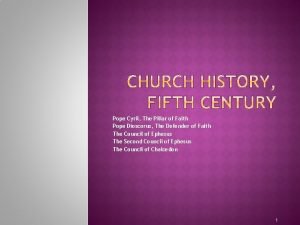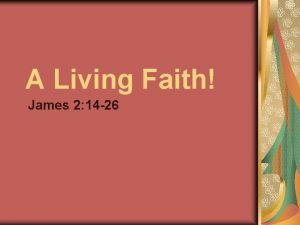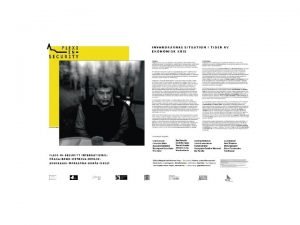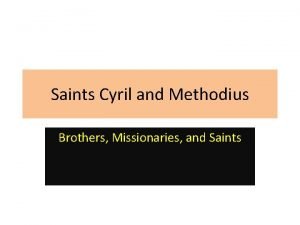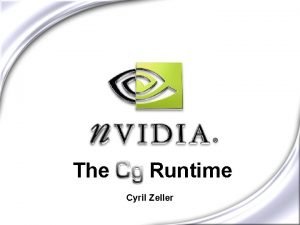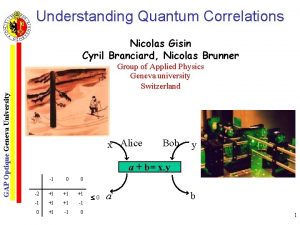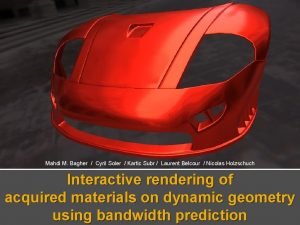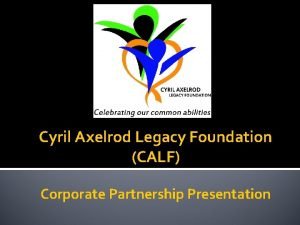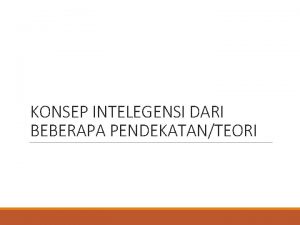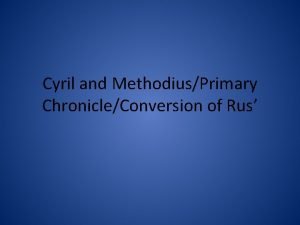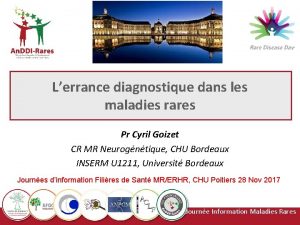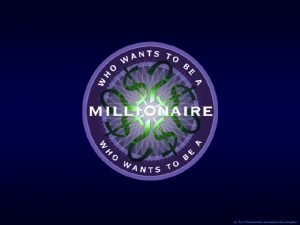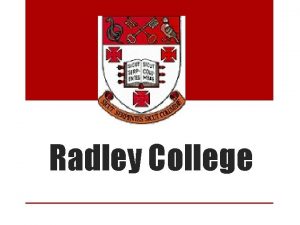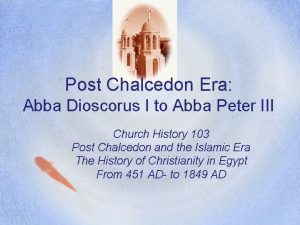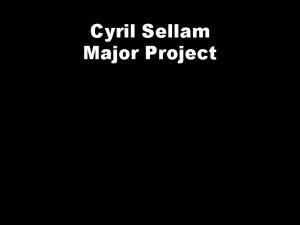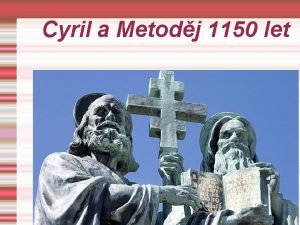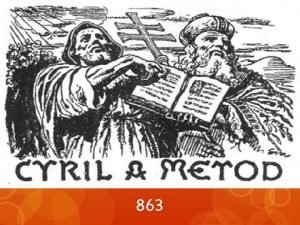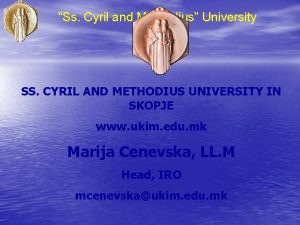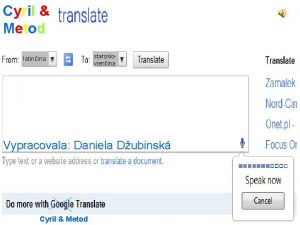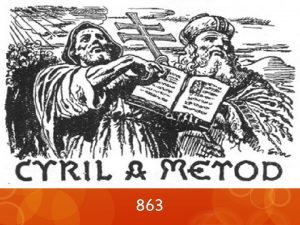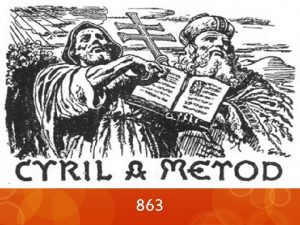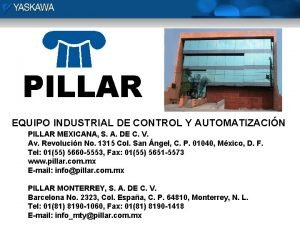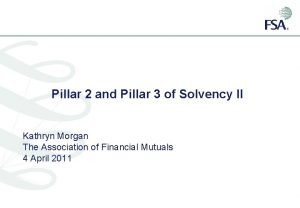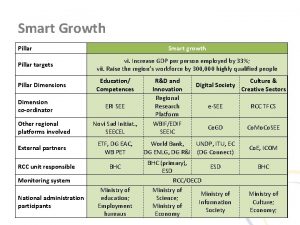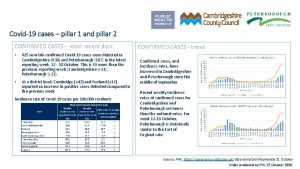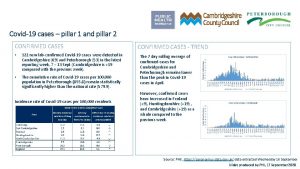Pope Cyril The Pillar of Faith Pope Dioscorus




















- Slides: 20

• Pope Cyril, The Pillar of Faith • Pope Dioscorus, The Defender of Faith • The Council of Ephesus • The Second Council of Ephesus • The Council of Chalcedon 1

2

� Short Biography: + Born 376 AD (Son of the sister of his predecessor Pope Theophilus, 23 rd Patriarch). + Ordained deacon, then priest in Alexandria‘s Cathedral. He captured the hearts of his listeners with his eloquence, fluency, and his strong influence. + Unanimously elected Pope on October 17, 412 AD. + Departed on June 25, 444 AD after steering the Church through storm and calm for c. 31 years. 3

� God’s Purpose in St. Cyril’s Life: + Educated at the school of Alexandria where he studied theological and philosophical subjects needed to defend the faith. + Spent 5 years at St. Macarius’ monastery where he assimilated the wisdom of the desert fathers (from Abba Sarabamoun). + Spent few months with Bishop Serapion where he increased wisdom and knowledge. 4

�St. Cyril’s Achievements: + Defended the Church against the apostasies of Emperor Julian. + Central figure in the First Council of Ephesus in 431 AD, led to the deposition of Nestorius, Patriarch of Constantinople. 5

�St. Cyril’s Achievements, cont. : + His great devotion to the dogma of the Incarnation. + His great devotion to the Holy Eucharist. + His monumental works of commentaries on the Holy Scriptures. 6

� St. Cyril’s Achievements, cont. : + His Ecumenical Stature : � One of the Great Doctors of Eastern Orthodox Churches. � Doctor of the Church in the Catholic Church (also venerated by Anglicans and Lutherans). � Called: Pillar of Faith, 2 nd Athanasius, Daring Lion, Burnished Lamp, Seal of all the Fathers. 7

�Events during St. Cyril’s Life: + Expulsion of Novatians and Jews from Alexandira. + Death of the hellenistic philosopher Hypatia. 8

THE 3 RD ECUMENICAL COUNCIL � Christ’s Two Nature Heresy � Against the Theotokos Heresy � 1 st Council of Ephesus � 2 nd Council of Ephesus � The Council of Chalcedon 9

THE 3 RD ECUMENICAL COUNCIL � By Nestorius Patriarch of Constantinople 1) 2) Christ’s Two Nature Heresy The Heresy: • Christ was 2 separate persons; a human born from St. Mary then the divine settled in it. • The divine Christ could not suffer nor die on the cross. The Defense: 3) • • • St. Cyril the 24 th Pope of Alexandria The union of the divinity with humanity occurred at the same time in St. Mary’s womb The two nature in Christ are without mix or change => the example of the molten iron in fire 10

THE 3 RD ECUMENICAL COUNCIL � Against the Theotokos Heresy 1) By Nestorius Patriarch of Constantinople 2) The Heresy: • St. Mary gave birth to the human Christ and thus cannot have the title “Mother of God” The Defense: 3) • • The nature of the Word was not originated by St. Mary but the Word was hypostatically united with the flesh in the sanctified St. Mary’s womb The human mother has no share in creating the spirit of her child yet she is the mother of the whole person not only his physical nature 11

THE 3 RD ECUMENICAL COUNCIL �The 1 st Council of Ephesus 1) Called by Emperor Theodosius at 431 AD 2) Attended by 200 bishops; the main figure is St. Cyril the 24 th Pope of Alexandria 3) The council excommunicated Nestorius, exiled to Ekhmim in upper Egypt until died 4) The council laid down the beginning of the creed “We exalt you, O mother of the true Light…. ” 12

13

�Short Biography: + Born in Alexandria. + Was elected and consecrated Pope in 449 AD. + Attained the Crown of Confession in his exile in Gangra island in 451 AD (17 September= 7 th of Tute 167 AM). 14

�God’s Purpose in St. Dioscorus’ Life: + Studied the Christian theology and was dean of the Catechetical School of Alexandria. + Was a pupil and secretary to Pope Cyril the 24 th Pope of Alexandria. + Accompanied Pope Cyril at the third ecumenical council at Ephesus. 15

� St. Dioscorus’ Achievements: + Defended Christ’s nature. The Alexandrian formula adopted by Sts. Cyril and Dioscorus was “one nature of God the Word Incarnate” which is in Greek “mia physis tou theo logou sesarkomene”. + He defended the faith in the second council of Ephesus in 449 AD against Eutychus and in the councils of Consantinople and Chalcedon (the Coptic Church does not recognise the latter two). 16

�Other Events during St. Dioscorus’ Life: + Emperor Theodosius the less asked him to convene the second council of Ephesus in 449 AD to settle theological disputes. + Emperor Marcianus and queen Pulcheria opposed Pope Dioscorus. . . 17

THE 3 RD ECUMENICAL COUNCIL �The 2 nd Council of Ephesus 1) Held at 449 AD to defend against the heresy of Eutyches (head of a monastery) 2) The other extreme of Nestorius; Christ has one Divine nature but took supernatural humanity; not a real one thus Christ is only Divine appeared in a human (Monophysite) 3) In the council, Eutyches and followers regretted their views and were forgiven 18

THE CHALCEDONIAN COUNCIL 1) Held at 451 AD to overcome the strong Coptic Patriarch and leadership 2) Pope Dioscorus of Alexandria (25 th) held a local council to excommunicate bishop “Leo” of Rome when he confessed the Nestorian heresy. 3) In turn, Leo held the Chalcedonian council and accused wrongly Pope Dioscorus with “Monophysite” , excommunicated and exiled him 4) This lead to the 1 st division in the church. 5) The right description of our church is “Miaphysite” 19

� In May 1973 H. H. Pope-Shenouda III of Alexandria visited H. H. Pope Paul VI of Rome. Their Common Declaration says: “We confess that our Lord and God and Savior and King of us all, Jesus Christ, is perfect God with respect to His divinity, perfect man with respect to His humanity. In Him His divinity is united with His humanity in a real, perfect union without mingling, without commixtion, without confusion, without alteration, without division, without separation. ” 20
